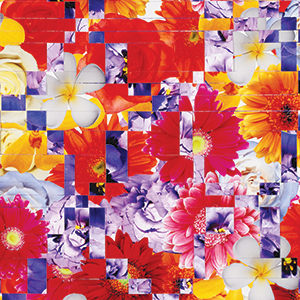Arts
Dinh Q. Lê's Beautiful Diaspora
 An untitled work from Dinh Q. Lê's 2006 series 'Tapestry,' one of many works in the artists sprawling new SJMA exhibit. Photo by San Jose Museum of Art
An untitled work from Dinh Q. Lê's 2006 series 'Tapestry,' one of many works in the artists sprawling new SJMA exhibit. Photo by San Jose Museum of Art
After receiving his art degrees in the US, the Vietnamese artist Dinh Q. Lê returned home to Vietnam for good in 1997, only to stumble across a powerful metaphor. He saw groups of clam diggers walking into the sea at low tide, baskets in hand and hats on their heads, in search of goods.
The scene triggered memories of own traumatic experiences of leaving the country by walking toward a boat at sea. In the West, we might call this a "full circle moment," but for Le the image resulted in his first video work, The Imaginary Country (2006), now on display at the San Jose Museum of Art.
The complete exhibit, "Dinh Q. Lê: True Journey is Return," is the artist's first major US show in over a decade and occupies almost all of the upstairs galleries. In a gorgeous way, Le transforms diasporic themes of exile, memory and global estrangement into a serene experience.
In one room, The Imaginary Country features floor-to-ceiling video projections of looped, overlapping footage. Larger-than-lifesize people walk into the sea with their baskets and their gear, ready to dig for clams. On the opposite wall, another projection documents the stories of 11 diasporic Vietnamese from the U.S., Canada and France, all of whom returned to Vietnam.
Some of them grew up in the West not knowing what their ancestral country looked like, while others were ruined by the perspectives of Hollywood and needed to see the real country. Their stories document the struggles involved with reclaiming one's heritage. The room thus immerses the viewer/participant with the sound of ocean waves collaged with human voices telling diasporic stories, all creating a cyclical meditative space of departure and return, with the past and future expanding and contracting like a rubber band. Themes of exile, longing and loss float to the surface. No matter how much Vietnam has changed, the sea might be the only true constant. One can imagine the stories it holds.
Yet this is just one room. The main experience of the show, Crossing the Farther Shore (2014) features seven large "cages," each one constructed with thousands of found photographs from Le's massive archive, all strung together with twine. Although suspended from the ceiling, the cages seem weightless, alluding to the mosquito nets that refugees like Le slept under in camps or perhaps the emotional prisoner-like experience refugees often suffer. One of cages has all the photos facing inward to acknowledge the misery and containment of the prisoners.
On the reverse of every photo are various texts, either inscriptions from their former owner, handwritten texts from the 19th-century epic poem "The Tale of Kieu" or recollections by Vietnamese-Americans gathered from the Houston Asian American Archive at Rice University, where the installation was first shown. As such, the viewer/participant witnesses private and unknown identities stitched together with cultural, personal and historical narratives, all as an ethereal, atmospheric memory of Vietnam—history as cross-stitch, as embroidery. Inside the cages, hundreds of additional photos are strewn about the floor, perhaps an analogy for the number of people who escaped Vietnam. No one can know the exact number of photos, as there are too many to count, as with all refugee crises.
Continuing through the exhibit, one turns a corner into North Vietnam via more video installations. Light and Belief: Voices and Sketches of Life from the Vietnam War features North Vietnamese artist-soldiers bragging about the weaponization of art for political gain via statements like: "If artists love their country, they must be warriors on the battlefield of culture and ideology. Their weapons are pens, pencils, musical instruments and the singing voice." Accompanying the video on the opposite wall are 101 drawings and watercolors made by North Vietnamese artists-soldiers originally commissioned for Documenta 13 in Europe.
Counterpointing the commie bravado we find another video, Vision In Darkness: Tran Trung Tin, featuring interviews with friends and relatives of the artist, a former secretary of the Communist Party who later resigned. Six of his paintings on newsprint grace the wall across from the video.
At the reception, Le said he never really belonged in the US, and that Vietnam is his true home. Via this exhibit, we are lucky to join him in his journey.
Dinh Q. Lê: True Journey is Return
Thru April 7
San Jose Museum of Art
sjmusart.org


